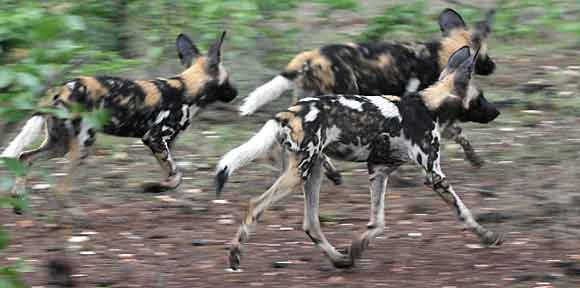Contact Details: Scotch Macaskill, Dirt Road Traders, Currys Post Road, Howick, KwaZulu-Natal, South Africa. Tel: +27 (0)82 578 2329. Privacy: Your privacy is guaranteed. See our Privacy Policy for more. This site accepts advertising and other forms of compensation - see Disclosure and Advertising for details. Site updated: 2022. Copyright © 2002 - 2022 Scotch Macaskill

| ||||||||||
|
||||||||||
|
SEE ALL
|
Wild Dogs are Efficient Hunters that Kill to Eatby Roddy SmithFew animals have been as maligned in popular belief or suffered for it as much as the African wild dog (Lycaon pictus). Dr Ian Macallum, in his book Ecological Intelligence, quotes (as an example of how even supposed experts are sometimes prone to misconceptions) a 1956 report by then director of Uganda National Parks in which he speaks of wild dogs "killing wantonly, far more than they need for food and by methods of utmost cruelty. They do not kill quickly as the lion does ... whenever they enter a particular stretch of country the disturbance they cause is so great that, for the time being, all buck are driven out. A particularly unpleasant characteristic is that they will without hesitation turn upon any member of the pack that falls by the way through wound or sickness." Most of this is complete nonsense, displaying woeful ignorance of the habits of both wild dogs and lions. I can only suppose that the author was simply repeating (and thereby reinforcing) old-time hunters' tales - a classic case of how these wild-life legends grow. Author Sir Laurens van der Post related how a friend with whom he was driving through the Kalahari suddenly leaped from the vehicle and shot five wild dogs because he considered them to be destructive vermin. Wild dogs are certainly extremely efficient hunters, with probably the highest success rate of any large African predator, and unlike most other predators they do not scavenge, eating only what they kill themselves.
Because they hunt primarily by sight and their method of running the prey down over distance results in a considerable rise in body temperature, they hunt in the cool of the day, generally early morning or evening but also sometimes by full moon or in the middle of the day if it is cool and overcast. Unlike the big cats, which stalk slowly and stealthily until they are close enough to make a short-range charge, wild dogs make no effort to conceal themselves on the hunt. They trot along quite openly until they see their prey. Most Usual QuarryTheir most usual quarry in our area (Lower Zambezi National Park, Zambia) is impala, and it is interesting to note that while impala which sight lion or leopard at a distance will stand and watch them, snorting out their alarm call, when they see wild dogs they flee immediately.On the other hand, other animals seem to know they are not at risk. I have watched wild dogs trot right past a troop of baboons foraging on the ground without either party displaying much interest. As soon as the prey does run, the wild dogs take off after them. Antelope are initially faster but the dogs soon wear them down, and the only hope for the selected animal is to get to water (wild dogs are generally reluctant to follow across deep water, but it has happened) or thick bush before that happens. It is widely believed that the wild dogs run in relays, but what actually happens is that the prey often runs in an arc, presumably trying to get back to its home range, and the hind-most dogs take the direct route across the arc. Scraps of Skin and BoneWhen the dogs finally catch up to impala or similar-sized animals, they pull them down very quickly and devour them with astonishing speed; a pack of six dogs will reduce an impala to scraps of skin and bone in under 20 minutes. Wild dogs also sometimes take on larger animals such as kudu and even zebra. The only way they can kill animals so much bigger than themselves is to jump up and bite chunks out of it until exhaustion and weakness allow them to pull it down. This is the origin of the reputation for "cruelty", but in fact the whole process is fairly quick, and certainly no more drawn-out than lions killing buffalo. Unlike the fiercely competitive, strongest-first behaviour of lions or hyenas at a kill, young and injured wild dogs that can't keep up are usually given preferential access to the carcase once they arrive. When puppies are too young to follow the hunt the other wild dogs will regurgitate meat for them, and for any adult which may be "baby-sitting". Sometimes a pack will become separated and kill more than one animal, and if it is a big pack they may have to do so. Nevertheless they will always eat as much as they can of whatever they kill, and any left-overs will go to the vultures just as happens with any other predator. Fortunately nowadays expert opinion is generally based on scientific observation rather than relying on hunters' tales, although these tend to persist in popular folk-lore. See also Wild Dog Information and Wild Dog Society - All About Co-Operation. Roddy Smith is a wildlife conservationist and safari guide based at Mwambashi River Lodge in the Lower Zambezi National Park, Zambia. Images © Scotch Macaskill Return to Wildlife Articles |
|||||||||
|
|
||||||||||
